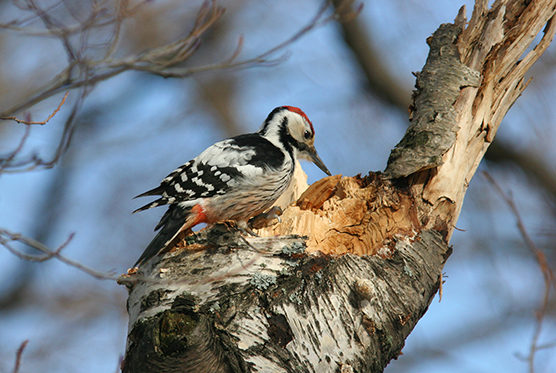
White-backed woodpecker © Antti Below
UPM, WWF Finland, Finnish Environment Institute and Metsähallitus Parks & Wildlife Finland have carried out a joint project to promote the living conditions of the endangered white-backed woodpecker in commercial forests. During the last 20 years, the population of the white-backed woodpecker has multiplied thanks to the conservation and management activities of its natural habitat. Today there are more than 200 pairs of white-backed woodpeckers nesting in our forests.
"This project has offered us plenty of new information regarding the living conditions of the white-backed woodpecker," says Sami Oksa, Manager, Sustainable Forestry, UPM. "Even a small forest area with broad-leaved trees can offer a great deal for the woodpeckers. They find enough food in single broad-leaved trees and build nests in the trees that are left in a regeneration felling area. Therefore, leaving enough broad-leaved trees and dead wood in commercial forests ensures good living conditions for the white-backed woodpecker," says Oksa.
"The conservation measures over the last 20 years have been very successful," says Markku Mikkola-Roos from the Finnish Environment Institute. "Doubling the number of nesting pairs will happen in the commercial forests," he continues.
Metsähallitus is responsible for monitoring the white-backed woodpecker and promoting its conservation. Senior Conservation Biologist Pekka Heikkilä confirms that, thanks to recent efforts, the white-backed woodpecker has been removed from the list of critically endangered species. "I'm very happy to see that the woodpecker population is growing continuously. Good forestry practices, such as leaving broad-leaved trees among coniferous trees, have also had a remarkable effect on the size of the population," says Heikkilä.
WWF Finland, an active partner in the project, sees the positive impacts in a wider context. "The efforts to improve the habitat of the white-backed woodpecker are also helping other endangered species," says Annukka Valkeapää, Forest Expert from WWF Finland. "Increasing the number of broad-leaved trees and the amount of dead wood in commercial forests is important for several species. So, even if the white-backed woodpeckers do not immediately find their way into the forest, the effort has not gone to waste," Valkeapää reassures.
The project partners have prepared a guide to help forest owners and forestry professionals support the conservation of the white-backed woodpecker. The White-Backed Woodpecker and Forestry Guide can be downloaded on the web sites of all partners. The guide aims to promote the population of white-backed woodpeckers and other broad-leaved forest species in commercial forests without compromising profitability.
White-backed Woodpecker and Forestry Guide (pdf, 2,7 MB)
For further information on the project, please contact:
Sami Oksa, Manager, Sustainable Forestry, UPM, tel. +358 40 560 3474
Annukka Valkeapää, Forest Expert, WWF Finland, +358 50 305 5086
Pekka Heikkilä, Senior Conservation Biologist, Metsähallitus, tel. +358 40 831 2874
Markku Mikkola-Roos, Senior Researcher, Finnish Environment Institute, tel. +358 400 148 685
UPM
UPM leads the reformation of the bio and forest industries. We are building a sustainable future in six business areas: UPM Biorefining, UPM Energy, UPM Raflatac, UPM Paper Asia, UPM Paper Europe and North America and UPM Plywood. Our products are made of renewable raw materials and are recyclable. We serve a global base of customers. We employ approximately 20,000 people, and our annual sales are approximately EUR 10 billion. UPM's shares are listed on NASDAQ OMX Helsinki. UPM – The Biofore Company – www.upm.fi/en
WWF Finland
WWF Finland is part of an extensive global WWF network with offices in approximately 50 countries and activity in over 100 countries. We are building a future where humans and nature can live in harmony with each other. We protect nature and solve some of the world's most severe environmental problems by encouraging people to engage in positive changes for the environment and their own well-being. www.wwf.fi/en
Metsähallitus
Metsähallitus manages and uses state-owned land and water areas in a sustainable and responsible manner. Our operations are based on utilizing renewable nature resources with expertise, promoting biodiversity and cooperating with regional bodies. The nature services at national parks and hiking areas that are publicly funded have a significant economic impact regionally. www.metsa.fi/sivustot/metsa/en
Finnish Environment Institute
The Finnish Environment Institute (also known as SYKE, after the Institute's Finnish acronym) is both a research institute, and a centre for environmental expertise. SYKE forms part of Finland's national environmental administration, and mainly operates under the auspices of the Ministry of the Environment, although the Institute's work related to water resources is supervised by the Ministry of Agriculture and Forestry. We have the skills, ambition and courage to open new avenues for improving the environment. www.syke.fi/en